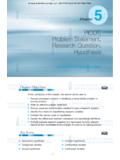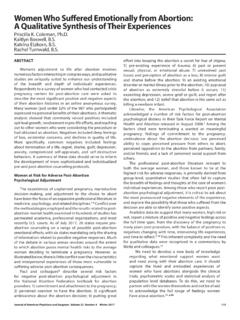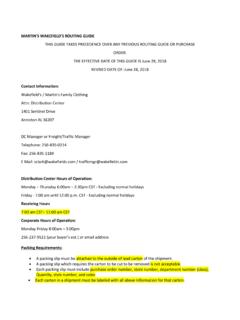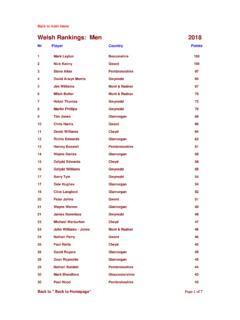Transcription of Procurement and process design Peter Boswell …
1 Procurement and process design Peter Boswell and Lorna Walker To achieve sustainable buildings and construction processes, strategies, policies and initiatives are needed to improve and enhance Procurement and project delivery systems employed by private owners and government clients. However, fundamental concerns are hindering progress in many areas. Contents The project 1 Project 2 3 Quality-based selection in 10 Innovative methods of project 11 Performance-based 13 Capacity 15 Sustainable development means achieving four objectives at the same time: effective protection of the environment; prudent use of natural resources; social progress which recognises the needs of everyone; and maintenance of high and stable levels of economic growth and employment. Buildings and the way they operate have a fundamental impact on the environment, consume large quantities of resources, involve large numbers of workers, and represent a large proportion of economic activity, so decisions made during all stages of the construction Procurement process are vital for maximising sustainability.
2 Sustainable building aims for no overall net environmental burden by considering a building s total economic and environmental impact and performance, from raw material extraction and product manufacture to building design , construction, operations and maintenance, and building reuse or disposal. Although sustainable building practices have, so far, been primarily voluntary it is anticipated they will become more prominent, and be reflected more strongly in Procurement and project delivery systems. The project cycle Constructing a building usually represents a major investment for an owner (individual, a private firm or a public agency). Since the investment is motivated by market demands or perceived needs to be met in a timely fashion, the building is expected to satisfy objectives specified by the owner and relevant regulations.
3 Most buildings, being non-speculative, are custom made in consultation with the owner. Since an owner is acquiring a building on a promise in some form of agreement, it will be wise for any owner to have a clear understanding of the acquisition process in order to maintain firm control of the quality, timeliness and cost of the completed building. Procurement in this context is the process that an entity initiating a project uses to achieve delivery of a project by obtaining services from both third parties and in-house providers, in conformance with applicable laws and regulations. The process spans the whole cycle, from identification of needs, through to the end of a services contract or the end of the useful life of an asset. Solutions at various stages are integrated to obtain the final outcome. Procurement processes have been brought to the fore with the realization that without a high quality of construction it will be difficult to ensure the required high performance standards for sustainable construction.
4 However, a 2001 FIDIC survey showed that that construction quality continues to deteriorate and is a worldwide problem involving both developed and developing countries. Poor quality arose owing to fundamental characteristics of Procurement by competitive tender (tight budgets; stake sharing; over-rigorous application of regulations; unfair selection; inexperienced, unfair and poorly transparent selection) leading to poor practice in virtually all areas (poor project supervision; poor materials; poor workmanship). Solutions need to address the entire Procurement process , hence the importance of understanding how Procurement works. Similarly, from the owner s perspective, with the advent of many alternatives for project delivery, selecting the method and Procurement process that match project requirements is crucial.
5 The owner may choose to decompose the entire process of construction or refurbishment into more or fewer stages, and thus obtain the most efficient results in implementation. Since operation and maintenance of a building will go on long after the completion and acceptance of a project, it is usually treated as a separate aspect except in the consideration of the life-cycle cost. All stages from conceptual planning and feasibility studies to the acceptance of a building are lumped together and referred to as the design -construct process . Stages may not be strictly sequential. Some require iteration, and others may be carried out in parallel or with overlapping time frames. All owners, both public and private, use outside agents to a greater or lesser degree when it becomes more advantageous to do so. By examining the project life cycle from an owner s perspective one can focus on the proper roles of various activities and participants in all stages regardless of the contractual arrangements for different types of work.
6 Project delivery Clearly stated objectives and knowing the balance between these objectives are fundamental for owners in deciding which project delivery system yields what the owner requires. Objectives and considerations include: - quality of the completed building. - need for independent expertise to develop the design , and selection of a design team. - required time schedule and delivery of a specific product. - appropriate risk allocation, by for example, transferring risk to those best able to manage it. - compliance with legal requirements and fulfilling legislative of executive intent. - financing alternatives, leading to say certain levels of cash flow. - contracting method best suited for the physical construction. - whether operation and maintenance should be bundled into project delivery or considered separately.
7 - need to accommodate a lack of definition at the early stage (some project delivery methods are better able to handle this situation). - control of the total project cost, The total project cost is clearly the most important consideration and the one most immediately affected by sustainability issues. It includes life-cycle costs and the initial construction cost ( first cost ). Saving small amounts of money during construction may not be worthwhile if the result is much larger operating costs or not meeting the functional requirements for the building. Thus, owners must be very concerned with the quality of the finished product as well as the cost of construction itself. 2 Since a building s operation and maintenance is a part of the project life cycle, the owners expectation to satisfy investment objectives will require consideration of the cost of operation and maintenance.
8 Therefore, the building s operating management should also be considered as early as possible, just as the construction process should be kept in mind at the early stages of planning and programming. Adopting sustainability recognizes this need to internalise costs. For example, calling for tenders to achieve lowest price may seem like an attractive option, but once all external costs such as future costs due to lack of quality are internalised, the outcome may be different. design -Bid-Build The traditional design -bid-build (DBB) process is widely used and relatively straightforward: construction is separated into design and physical production as a phased process involving definition of the project structure and project management approach, followed by project planning, the evaluation of possible delivery methods, the formulation of a design brief, design , cost plan and programme, contract preparation, tendering and construction.
9 Since there is a succession of discrete activities or phases, requiring completion and possibly separation in time, it is an orderly process with clear lines of authority, scope of services and schedules, where all designs are completed before construction starts resulting in a high level of certainty of what will be constructed. Strategic, concept planning, project programming and needs stage Implementing sustainability issues starts at the strategic and concept planning and project programming stage where the technical and economic feasibility of alternatives will be compared in order to select the best possible project. Sustainability decisions made at the beginning of a project life cycle have a far greater influence than those made at later stages since design and construction decisions will influence the continuing operating costs and, in many cases, revenues over the building s lifetime.
10 For public owners, it will usually not be Procurement staff who set the user s requirements and develop the business case, so it is essential that all stakeholders work closely together to ensure that full advantage is taken of the scope available to consider sustainability issues before the subsequent development of specifications. Multilateral development banks and other international finding agencies have traditionally been very weak in identifying needs. Prior to setting a specification, there is little in terms of Procurement policy or legislation that affects the scope for taking sustainability into account. However, efficient and effective use of financial resources does, of course, need to be assured. To gain time, some owners forego thorough planning and feasibility study and proceed with inadequate definition of the project scope.






